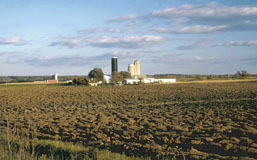|
|
Transport of a chemical compound in the
environment depends on its mobility. Some compounds, such
as nitrate and atrazine, readily dissolve and move with water
in both streams and ground water. Many forms of phosphorus,
however, attach to soil particles rather than dissolve; a
large proportion of such compounds is transported to streams
with eroded soil, particularly during times of high runoff
from precipitation or irrigation. Ground water typically is
not vulnerable to contamination by compounds that attach to
soils.
The transport of a chemical compound in
the environment also depends on its persistence. Some
pesticides are not readily broken down by microorganisms or
other processes in the natural environment. For example, DDT
and chlordane can persist in soil, water, sediment, and animal
tissue for years and even decades. Other pesticides, such
as carbaryl, are relatively unstable in water and break down
to other compounds in days or weeks. Chemical compounds that
persist for a long time are likely to be transported farther
than compounds that are short-lived.
|

image size 85KB
Photo by Jana S. Stewart

image size 104KB
Photo by Jeffrey D. Stoner

image size 48KB
(photo by David F. Usher)
|
Some of the highest levels of nitrogen occur in streams and
ground water in agricultural areas
Applications of fertilizers, manure, and pesticides have degraded
the quality of streams and shallow ground water in agricultural
areas and have resulted in some of the highest concentrations of
nitrogen measured in NAWQA studies. Concentrations of nitrogen in
nearly half of the streams sampled in agricultural areas ranked
among the highest of all streams measured in the first 20 Study
Units. Concentrations of nitrate exceeded the USEPA drinking-water
standard of 10 milligrams per liter (as nitrogen) in 15 percent
of samples collected in shallow ground water beneath agricultural
and urban land, signifying a possible concern in some rural areas
where shallow aquifers are used for drinking-water supply.
Phosphorus is elevated, too
Compared to nitrogen, a smaller proportion of phosphorus (originating
mostly from livestock wastes or fertilizers) was lost from watersheds
to streams. The annual amounts of total phosphorus and total nitrogen
measured in agricultural streams were equivalent to less than 20
percent of the phosphorus and less than 50 percent of the nitrogen
that was applied annually to the land. This is consistent with the
general tendency of phosphorus to attach to soil particles and move
with runoff to surface water. Even with the lower losses from land
for phosphorus than for nitrogen, however, phosphorus is more likely
to reach concentrations that can cause excessive aquatic plant growth.
Nitrogen concentrations are rarely low enough to limit aquatic plant
growth in freshwater, whereas phosphorus concentrations can be low
enough to limit such growth. Hence, excessive aquatic plant growth
and eutrophication in freshwater generally result from elevated
phosphorus concentrations (typically greater than 0.1 milligram
per liter). In contrast, nitrogen is typically the limiting nutrient
for aquatic plant growth in saltwater and coastal waters.
Pesticides—primarily herbicides—are found frequently in agricultural
streams and shallow ground water
Extensive herbicide use in agricultural areas (accounting for about
70 percent of total national use of pesticides) has resulted in
widespread occurrence of herbicides in agricultural streams and
shallow ground-water. The highest rates of detection for the most
heavily used herbicides—atrazine, metolachlor, alachlor, and cyanazine—were
found in streams and shallow ground water in agricultural areas.
Insecticides were frequently detected in some streams draining watersheds
with high insecticide use but were less frequently detected in shallow
ground water because most insecticides are applied at lower levels
than herbicides and tend to sorb onto soil or degrade quickly after
application.
Health effects of pesticides are not adequately understood
Concentrations of individual pesticides generally were low compared
to USEPA drinking-water standards and guidelines; pesticides exceeded
standards or guidelines in less than 1 percent of sampled wells.
This good news, however, is tempered by the current uncertainty
in estimating risks of pesticide exposure. For example, most contamination
occurred as pesticide mixtures, such as atrazine, metolachlor, and
other pesticides, whereas most toxicity and exposure assessments
are based on controlled experiments with a single contaminant. In
addition, some breakdown products, for which there are no established
standards or guidelines, may have effects similar to their parent
pesticides. Finally, water-quality standards and guidelines have
been established for only about one-half of the pesticides measured
in NAWQA water samples.
Aquatic life may be at more risk than human health
Effects on aquatic organisms may be greater than on humans in many
agricultural areas. Although there are no USEPA aquatic-life criteria
for the major herbicides, Canadian guidelines were exceeded at 17
of the 40 agricultural streams studied, most commonly for atrazine
or cyanazine. Also, currently used insecticides exceeded guidelines
for aquatic life in at least one water sample from 18 of the 40
agricultural streams. The major organochlorine insecticides, such
as DDT, dieldrin, and chlordane (which no longer are used but remain
widely detected in sediment and fish in agricultural streams) exceeded
recommended sediment-quality guidelines for protection of aquatic
life at about 15 percent of agricultural sites.
|